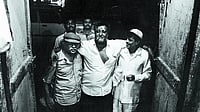Move over Mulk Raj Anand, Thakazhi Sivasankaran Pillai, Shivarama Karanth, Premchand and Arundhati Roy.Bakha (Untouchable, 1933), Chudalamuthu (Thottiyude Magan, 1919), Choma (Chomana Dudi,1931), Dukhi (Sadgati, 1933) and Velutha (The God of Small Things, 1997) have found their ownvoices. Their stories – told in Marathi, Tamil, Hindi, Kannada and Telugu – are now being translated intoEnglish. And French and Spanish. They no longer depend on empathetic non-Dalits, with no firsthand experienceof Dalithood, to tell the world their story. In fact, Dalit writing seems to be getting on the list of everymajor publisher in India. It is also being taught in universities in India and abroad.

Narendra Jadhav’s memoir Outcaste:A Memoir was published last month by Penguin, but only a year after the French publisher Fayard hadissued it as Intouchable and sold a phenomenal 20,000 copies [Please see interview ].Jadhav, currentlyhead of economic research in RBI, first wrote his work in Marathi in 1992 as Aamcha Baap Aan Mahi (MyFather and Us) and it soon became a bestseller. Soon, the three-generation saga will be in your homes as a52-episode TV serial.
Publishing dalit writing in English has had a chequered history. The first major rendition of Dalitliterature into English, Poisoned Bread, came in 1992, from Orient Longman. But this anthology ofMarathi Dalit writing, edited by ‘Dalit Panther’ Arjun Dangle, was not followed up. In 2000, MiniKrishnan, currently translations editor with Oxford University Press, commissioned and issued Tamil Dalit-feministwriter Bama’sautobiography, Karukku,which went on to win the Crossword Award that year. Soon, other mainstream publishers began queuing up forDalit writing in translation.
The last few years have seen not just English translations, but also keen interest from publishers abroad,particularly the French. Bama’s second work, Sangati, was first translated into French (the Englishversion in India is forthcoming from OUP).

The French were again the first to publish Viramma: Life of aDalit in 1995, an auto-ethnography in which the life of an unlettered Dalit woman from Tamil Nadu wasrendered in French by Josiane Racine and Jean-Luc Racine. And at last year’s Les Belles Etrangeres literaryfestival (literally, Beautiful Foreigners) in Paris, Jadhav and Bama rubbed shoulders with U.R. Ananthamurthy,Upamanyu Chatterjee, Mahashweta Devi and suchlike. Vasti, the autobiography of Vasant Moon, the scholarwho edited the collected works of B.R. Ambedkar, was issued in English by the American publisher Rowman andLittlefield (reprinted in India by Sage).
Gail Omvedt, historian of the Dalit movement who translated Moon’s work as Growing Up Untouchable inIndia (2001) and whose biography of Ambedkar is forthcoming from Penguin, puts this phenomenon inperspective:
"Dalits are taking advantage of globalization. Since the World Conference on Racism in Durban, theyhave shown an ability to inter-link, use the internet, make alliances with other oppressed groups like AfricanAmericans, and organise themselves. And since they’re more humane, more interesting and dramatic and have amore truthful cause than their brahmanical and upper caste opponents, they are winning a market as well."

And the market has its preferences: it loves autobiographies. Hot from OUP’s press is Akkarmashi: TheOutcaste, Sharankumar Limbale’s life-story. Omprakash Valmiki’s Hindi autobiography Joothan: ADalit’s Life was published this year by Kolkata-based Samya. Earlier, Kishore Shantabai Kale’s AgainstAll Odds, another autobiography from Marathi, came from Penguin. Orient Longman is considering AravindaMalagatti’s autobiography Government Brahmana, a modern classic in Kannada. Moon, Bama and Jadhavalso narrate life-stories. Says Sivakami, an IAS officer whose self-translated Tamil novel is forthcoming fromOrient Longman:
"I think the Durban conference on racial discrimination created an awareness among the internationalcommunity on the Dalit issue. Translation of Dalit writings into English and other foreign languages iswelcome. It provides space for a fair and free discussion on the subject."
A publisher’s attraction to Dalit writing is not purely driven by commerce as OUP’s Mini Krishnanexplains:
"Anti-caste protest literature is distinguished by both an experience that we don’t share, and a useof speech-styles that have long been considered unacceptable. When in college not only had I not read a Dalitwriter, I hadn’t even read about Dalit writers. And I was supposed to be well read! The market shouldbe sensitised. As publishers, we have a social responsibility."
Dalit literature is slowly emerging as a discipline of academic study as well. The department of English atthe University of Pune features Dalit and African American literature in a course entitled ‘Literature ofProtest’. Jamia Millia Islamia has received support for an endowed chair in Dalit Studies from the FordFoundation. The syllabus of the Telugu optional paper for the UPSC exam lists ‘Dalit Literature’ as one ofthe necessary areas of study. But the attitude of non-Dalits takes longer to change. K. Satyanarayana, whoteaches at Hyderabad’s Central Institute of English and Foreign Languages, offers the proof of experience:
"I offered Dalit Studies as one of the courses in M.A. in 2000. Only one student registered initially.I wanted to scrap the course. But friends advised me to persist. Eventually, eight students joined. Only onewas a non-Dalit, a Christian. None of the Brahmin students enrolled."
But serious lobbying is under way. In May 2003, NRI Dalits organised an international conference inVancouver, inaugurated by former president K.R.Narayanan. One of the resolutions adopted was:
"Dalit Studies must be included in Indian and international educational and research institutions,especially in North America and Europe."
Says K.P. Singh, who teaches South Asian Studies and Sociology at the University of Washington and one oforganisers of the Vancouver conference:
"When I came to the US in 1995, I found scholars focusing on religions in India. But today, Americanuniversities offering South Asian Studies are thinking positively about Dalits issues. I have offered twospecial courses: on ‘Post-Colonial Dalit Literature’ and another on ‘Race, Caste, and Ethnicity’."
However, even in Canada, there’s an echo of Satyanarayana’s experience. "My courses attract moreAmerican students than Indian-origin students," observes Singh.
It is this potential that perhaps made OUP issue The Essential Writings of B.R. Ambedkar last year.And publishers are grabbing what little is coming in. Says Mandira Sen, who published Joothan,"The US and UK rights for Joothan were bought by Columbia University Press. It is hoping that thebook will be prescribed in US undergraduate courses. If Americans have Anita Desai and Arundhati Roy on theirreading lists, why not a Dalit text?"
Arundhati Roy, whose God of Small Things features a Dalit character Velutha, of course has noproblems, but she cautions:

"This surge in publishing Dalit literature, if it has to be taken seriously, has to ride on the backof a contemporary civil rights movement. Otherwise, mainstream publishers will only use it for commercialgains. The only other realm where we have seen Dalit assertion is in electoral politics, but there’s adownside to it: it is not very liberating."
But the prioritisation of autobiographies and the politics of publishing worries some critics from within.Says Ravikumar, activist-theoretician of the Dalit movement in Tamil Nadu whose nonfiction is being translatedfor Samya,
"Where translation into English plays mischief is in the selection. Those who publish, translate andintroduce Dalit writing are all non-Dalits whose choices are inflected by what they find least threatening –autobiographical literature of pain and suffering. They rarely engage with the work of Dr. Ambedkar. Theproblem is, unlike with blacks and feminist, autonomous Dalit publishing has not emerged in India."

Ravikumar
Reflecting the publishers’ tendency to stereotype are the titles given to dalit writing, where ‘untouchable’,‘outcaste’ or ‘Dalit’ continue to figure on the cover.
Those who want to grapple with the issue of how to respond to Dalit literature will soon be able to readSharankumar Limbale’s Marathi work Towards and Aesthetics of Dalit Literature in English (from OrientLongman). Says the translator Alok Mukherjee, who teaches literature at York University, Toronto,
"Limbale characterises the non-Dalits’ preference and response to the representation of Dalit miseryas liberal-reformist. One could conjecture that they fit into the penchant for ‘discourses of pity’ ratherthan for literature that prompts one to take social action."
Satyanarayana too points to such problems:
"Sisir Kumar Das reduced Dalit writing as ‘narratives of suffering’ in his monumental 11-volumeSahitya Akademi project on Indian Literary History (only two volumes are out)."
A humane future lies, it appears, in not just publishing Dalit literature but in admitting and doingsomething about social realities specific to India. Warns Roy:
"I do believe that in India we practice a form of apartheid that goes unnoticed by the rest of theworld. And it is as important for Dalits to tell their stories as it has been for colonized peoples to writetheir own histories. When Dalit literature has blossomed and is in full stride, then contemporary (uppercaste?) Indian literature’s amazing ability to ignore the true brutality and ugliness of the society inwhich we live, will be seen for what it is: bad literature. It will become irrelevant."
But does reading Dalit narratives make non-Dalits sensitive to issues of untouchability and casteism?Satyanarayana does not think so:
"Reading literature and responding to issues of discrimination are not necessarily connected. OurBrahmin academics do read a lot of Black literature. But this doesn’t affect their response to day-to-daydiscrimination of Dalits here."
What would go a long a way in sensitising young upper caste minds, according to him, is introducing Dalitwriting from Ambedkar to Omprakash Valmiki from the kindergarten to PG level. Such curriculum changes may havea long way to go, but the spurt in publishing Dalit writing will sure have a trickle-down effect.
They are telling their own stories. Others must begin to listen and unlearn.
A slightly condensed version of this appears in the print magazine.


























